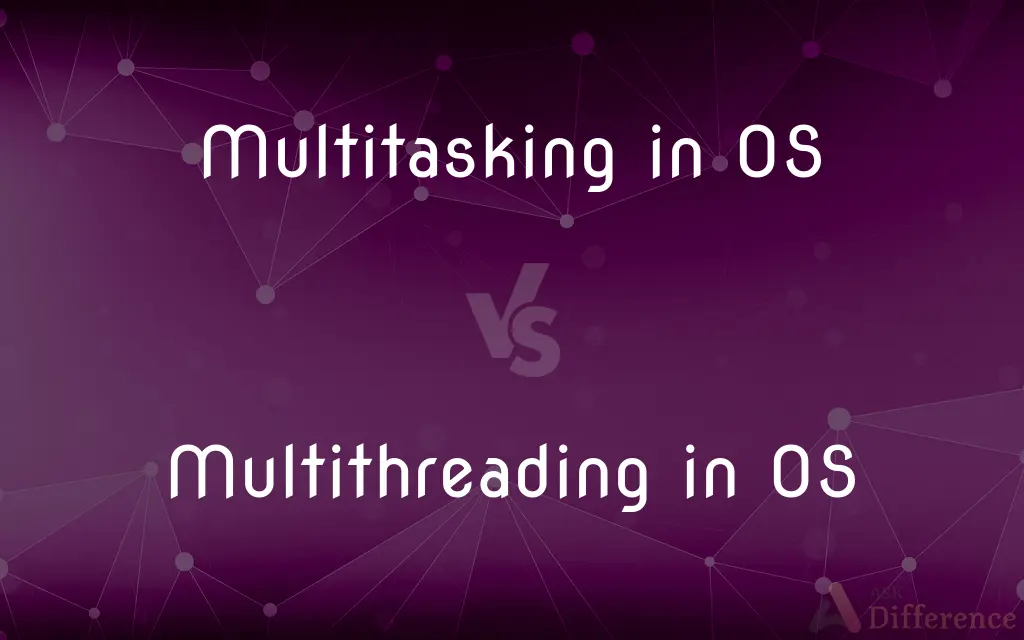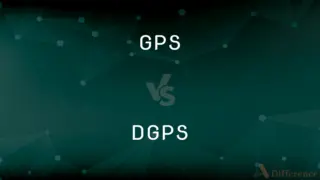Multitasking in OS vs. Multithreading in OS — What's the Difference?
By Tayyaba Rehman — Published on January 4, 2024
Multitasking in OS refers to running multiple applications simultaneously; multithreading involves multiple threads within a single application for concurrent task execution.

Difference Between Multitasking in OS and Multithreading in OS
Table of Contents
ADVERTISEMENT
Key Differences
Multitasking in an operating system (OS) allows multiple applications or processes to run concurrently, allocating time and resources among them. Multithreading, a subset of multitasking, is the capability of an OS to manage different parts of a program, called threads, to run concurrently within a single application.
In multitasking, the OS manages the execution of different programs, providing the illusion that they are running simultaneously. This involves switching the CPU among tasks. In multithreading, the focus is on executing multiple threads within the same application, often improving the application's performance and responsiveness.
Multitasking involves context switching at the process level, where the state of a process is saved and restored. This can be more resource-intensive. Multithreading involves context switching at a thread level, which is generally lighter and quicker since threads within the same process share the same memory space.
In multitasking, each application runs in its own memory space, providing isolation and security among different applications. Multithreading, by contrast, requires careful synchronization since threads share the same memory space within an application, which can lead to issues like data corruption if not managed correctly.
Multitasking is essential for modern computing where users expect to run multiple applications simultaneously, like a web browser, a word processor, and a music player. Multithreading is crucial in applications requiring concurrent operations, such as a web server handling multiple requests or a graphical application providing smooth user interaction.
ADVERTISEMENT
Comparison Chart
Scope
Multiple applications/processes
Multiple threads within a single application
Context Switching
Between processes
Within the same application (between threads)
Resource Isolation
Each process has its own memory
Threads share the same application memory
Synchronization Complexity
Managed at the OS level
Requires careful management within the application
Typical Use
General operation of a computer system
Specific applications needing concurrent processing
Compare with Definitions
Multitasking in OS
Efficiently managing multiple applications.
The OS's multitasking capabilities enabled switching between a spreadsheet and email client seamlessly.
Multithreading in OS
Sharing a program's resources among multiple threads.
In the database application, multithreading managed multiple queries concurrently.
Multitasking in OS
Allocating CPU time to different tasks.
The OS's multitasking divided CPU time between running a video call and downloading files.
Multithreading in OS
Enhancing application responsiveness.
Multithreading allowed the game to handle user input while rendering graphics simultaneously.
Multitasking in OS
Running several programs simultaneously.
Multitasking in the OS allowed browsing the internet while listening to music.
Multithreading in OS
Concurrent processing within a single application.
The web browser used multithreading to load multiple tabs at the same time.
Multitasking in OS
Concurrent execution of multiple processes.
Multitasking ensured that the antivirus scan ran in the background without interrupting work.
Multithreading in OS
Executing multiple threads within one program.
Multithreading in the OS improved the performance of the server application.
Multitasking in OS
Providing users the ability to perform various tasks at once.
Multitasking in the OS facilitated editing a document while compiling code.
Multithreading in OS
Dividing a program into independently running parts.
Multithreading was used to separate the GUI and computation in the software.
Common Curiosities
What is multitasking in an OS?
Running multiple applications simultaneously on a computer.
What is multithreading in an OS?
Running multiple threads within a single application for concurrent task execution.
Is multitasking dependent on the OS?
Yes, the OS manages multitasking by allocating resources among processes.
Does multithreading require synchronization?
Yes, to manage shared resources and prevent conflicts.
What are the risks of multithreading?
Risks include deadlocks and race conditions due to improper synchronization.
How do threads communicate in multithreading?
Threads communicate directly through shared memory and synchronization mechanisms.
What is context switching in multitasking?
It's the process of storing and restoring the state of a process to allow task switching.
Can multithreading be implemented in any programming language?
It depends on the language and its runtime environment; most modern languages support it.
How does multitasking impact CPU usage?
It allows the CPU to be used efficiently by managing time among multiple tasks.
Why is multithreading important in applications?
For improving performance and responsiveness by parallelizing tasks within an application.
Can multitasking cause system slowdown?
Yes, if too many tasks consume resources, it can slow down the system.
Do threads in multithreading share memory?
Yes, threads in multithreading share the same memory space of the application.
What's the difference in resource allocation between multitasking and multithreading?
Multitasking involves allocating resources among different applications, while multithreading allocates resources within a single application among its threads.
How does multitasking affect battery life on mobile devices?
It can drain the battery faster due to multiple active processes.
Can multitasking run on single-core processors?
Yes, though it's time-sliced, not truly parallel.
Share Your Discovery

Previous Comparison
Cache Memory vs. Register
Next Comparison
GPS vs. DGPSAuthor Spotlight
Written by
Tayyaba RehmanTayyaba Rehman is a distinguished writer, currently serving as a primary contributor to askdifference.com. As a researcher in semantics and etymology, Tayyaba's passion for the complexity of languages and their distinctions has found a perfect home on the platform. Tayyaba delves into the intricacies of language, distinguishing between commonly confused words and phrases, thereby providing clarity for readers worldwide.
















































